*NURSING > QUESTIONS & ANSWERS > NUR 2790 Nursing III Exam 3 Questions & Answers Complete. (All)
NUR 2790 Nursing III Exam 3 Questions & Answers Complete.
Document Content and Description Below
Chapter 65--Multisystem Failure MULTIPLE CHOICE 1. The nurse is caring for a client who has sustained multiple injuries from a motor vehicle accident. The nurse realizes that the client will have... a release of stress hormones that are useful for all of the following EXCEPT: 1. preventing loss of fluids. 2. preventing hypotension. 3. preventing infection. 4. preventing ingestion of food. ANS: 4 The purpose of the release of stress hormones following an insult to the body is to aid in restoring balance to the system and to prevent secondary complications, including loss of fluids, hypotension, and infection. The stress hormones are not released to prevent the ingestion of food. PTS: 1 DIF: Analyze REF: Neuroendocrine System Response 2. The nurse is planning care for a client diagnosed with acute respiratory distress syndrome (ARDS)? Which of the following is not included in the management of this disorder? 1. Treating the underlying cause 2. Promoting gas exchange 3. Providing oxygen therapyPromoting urine output ANS: 4 The nursing management of ARDS includes facilitating oxygenation and ventilation, which is accomplished by treating the underlying cause, promoting gas exchange, and providing oxygen therapy. Promoting urine output is not part of the management of this disorder. PTS: 1 DIF: Apply REF: Acute Respiratory Distress Syndrome: Planning and Implementation 3. The nurse, caring for a client diagnosed with shock, realizes that the stage in which the body attempts to remedy the problem by initiating the homeostatic mechanism would be? 1. Initial stage 2. Compensatory stage 3. Multiple organ failure stage 4. Refractory stage ANS: 2 During the compensatory stage, the body tries to remedy the problem. If it cannot, cellular damage will occur and organ failure and death may follow. During the initial stage, there is a decrease in cardiac output and impaired tissue perfusion. In multiple organ failure, every system in the body is affected. In the refractory stage, the body can no longer respond to therapy and the shock condition is considered irreversible. PTS: 1 DIF: Analyze REF: The Four Stages of the Shock Syndrome 4. A client experiences a bee sting, complains of difficulty breathing, and shows sign of hypoxia and hypotension. The nurse realizes these are signs of anaphylactic shock, and she should do which of the following first? 1. Get a medical alert bracelet for the patient. 2. Give epinephrine intravenously or via endotracheal tube. 3. Check with the family for a history. 4. Admit the client through the admitting department. ANS: 2 Anaphylactic shock is a medical emergency, and treatment is needed immediately. The nurse should expect to give epinephrine to promote bronchodilation and vasoconstriction. The other choices can be done after the client’s airway and ventilation are stabilized. PTS: 1 DIF: Apply REF: Anaphylactic Shock: Pharmacology 5. A client is diagnosed with failure of the left ventricle to provide adequate delivery of oxygen to the body tissues due to a weakened forward pumping function of the heart. The nurse realizes this client is experiencing: 1. anaphylactic reaction. 2. cardiogenic shock. 3. hypovolemia. 4. metabolic acidosis. ANS: 2 In cardiogenic shock, there is an impaired forward pumping function with decreased stroke volume and decreased cardiac output. This dysfunction results in a backup of blood into the pulmonary system, and it can cause metabolic acidosis. Anaphylactic shock is a systemic reaction to an antigen. Hypovolemia is a loss of circulating blood. Metabolic acidosis is an acid-base imbalance that can occur from a variety of health conditions or disease processes. PTS: 1 DIF: Analyze REF: Cardiogenic Shock 6. To assess if the renal system in a client diagnosed with multisystem failure is functioning properly, the nurse would expect to see urine output of: 1. 10 mL per hour. 2. 20 mL per hour. 3. 30 mL per hour. 4. 40 mL per hour. ANS: 3 Elimination of 30 mL per hour of urine is considered to be an approximate estimate of renal function. A urine output less than 30 mL per hour indicates renal failure. A urine output of greater than 40 mL per hour is considered within normal limits. PTS: 1 DIF: Apply REF: Box 65-6 Selected Manifestations of Cardiogenic Shock 7. The nurse realizes that a client, diagnosed with neurogenic shock, is at risk for developing: 1. skin breakdown. 2. sweating. 3. deep vein thrombosis. 4. infection. ANS: 3 The client is at a greater risk for deep vein thrombosis (DVT) because of the pooling of blood in the lower extremities. The client is at risk for skin breakdown, sweating, and infection; however, the risk for a DVT is a priority during the shock phase. PTS: 1 DIF: Analyze REF: Neurogenic Shock: Pathophysiology 8. A client is diagnosed with septic shock. The nurse realizes that the major cause of this type of shock is: 1. gram-negative bacteria. 2. gram-positive bacteria. 3. fungi. 4. viruses. ANS: 1 All are potential causes of septic shock, but gram-negative bacteria are considered the major cause of septic shock. PTS: 1 DIF: Analyze REF: Septic Shock: Pathophysiology 9. A client is diagnosed with cardiogenic shock. The nurse should plan interventions to address which of the following potential complications of this disorder? 1. Pulmonary embolism 2. Deep vein thrombosis 3. Renal failure 4. Myocardial infarction ANS: 4 In cardiogenic shock, there is a reduction in oxygenated arterial blood that decreases perfusion throughout the body. The most serious complication of cardiogenic shock is myocardial infarction. Pulmonary embolism, deep vein thrombosis, and renal failure are not considered the most serious complications of cardiogenic shock. PTS: 1 DIF: Apply REF: Cardiogenic Shock: Pathophysiology 10. The nurse is concerned that a client will develop neurogenic shock when which of the following is assessed? 1. Fractured left lower extremity 2. Spinal cord injury at T1 3. Jugular vein distention 4. Sluggish bowel sounds ANS: 2 Neurogenic shock is common following a spinal cord injury at or about T6. The client with a spinal cord injury at T1 is at risk for developing neurogenic shock. The other assessment findings do not place the client at risk for developing this type of shock. PTS: 1 DIF: Analyze REF: Neurogenic Shock 11. The nurse is planning care for a client diagnosed with disseminated intravascular coagulation. Which of the following should be included in this plan of care? 1. Avoid intramuscular injections. 2. Provide adequate daily caloric intake. 3. Perform range-of-motion exercises to all extremities twice a day. 4. Restrict fluids. ANS: 1 When planning care for a client diagnosed with disseminated intravascular coagulation, the nurse needs to incorporate careful handling of the client since bleeding occurs easily. Sharp objects are to be avoided such as razors and intramuscular injections. Dietary intake and range-of-motion exercises are important for all critically ill clients; however, avoiding sharps is the priority for a client with disseminated intravascular coagulation. There is no physiological reason to restrict fluids in this client. PTS: 1 DIF: Apply REF: Disseminated Intravascular Coagulation 12. A firefighter is brought to the emergency department with complaints of headache, weakness, shortness of breath, cough, and chest pain. During the assessment of this client, the nurse realizes the client should be evaluated for: 1. cyanide poisoning. 2. pulmonary emboli. 3. pneumonia. 4. stroke. ANS: 1 Smoke inhalation poses a risk of hydrogen cyanide poisoning, especially for firefighters. Clinical manifestations of this disorder include headache, weakness, shortness of breath, cough, and chest pain. The risk for pulmonary emboli, pneumonia, or stroke are not associated with fire or smoke inhalation. PTS: 1 DIF: Analyze REF: Red Flag: Fires, Smoke Inhalation and Cyanide Poisoning MULTIPLE RESPONSE 1. The nurse is assessing a client for the acute phase of the inflammatory immune response. Which of the following are considered cardinal signs of this response? (Select all that apply.) 1. Rubor 2. Tumor 3. Dolor 4. Scarring 5. Calor 6. Loss of function ANS: 1, 2, 3, 5 The cardinal signs of the inflammatory response include: rubor or redness; tumor or swelling; dolor or pain; and calor or heat. Loss of function is no longer considered a cardinal sign of the inflammatory response. Scarring is part of the healing response. PTS: 1 DIF: Apply REF: Inflammatory Immune Response; Nursing Strategy Feature: Cardinal Signs of Infection 2. The nurse is determining if a client is experiencing chronic inflammation. Which of the following are indications for this type of inflammation? (Select all that apply.) 1. Chronic elevation of white blood cells 2. Low-grade fever 3. Pain 4. Scar formation 5. Low blood pressure 6. Hematuria ANS: 1, 2, 3, 4 Chronic inflammation is characterized by chronic elevation of white blood cells, low-grade fever, pain, and scar formation. Low blood pressure and hematuria are not characteristics of chronic inflammation. PTS: 1 DIF: Analyze REF: Box 65-1 Characterizations of Chronic Inflammation 3. The nurse is assessing a client for systemic inflammatory response syndrome (SIRS). Which of the following disease processes are associated with this syndrome? (Select all that apply.) 1. Infection 2. Pancreatitis 3. Ischemia 4. Trauma 5. Massive transfusions 6. Heart failure ANS: 1, 2, 3, 4, 5 Disease processes associated with systemic inflammatory response syndrome include infection, pancreatitis, ischemia, trauma, and massive transfusions. Heart failure is associated with cardiogenic shock. PTS: 1 DIF: Analyze REF: Systemic Inflammatory Response Syndrome 4. A client is experiencing symptoms associated with distributive shock. What types of shock are included in this category? (Select all that apply.) 1. Neurogenic 2. Hypovolemic 3. Anaphylactic 4. Cardiogenic 5. Septic 6. Chronic ANS: 1, 3, 5 There are three basic categories of shock syndrome: 1) hypovolemic, 2) cardiogenic, and 3) distributive. Subcategories of distributive shock include neurogenic, anaphylactic, and septic. Chronic is not a type of shock. PTS: 1 DIF: Analyze REF: Shock Syndrome 5. The nurse is caring for a client experiencing hypovolemic shock. Which of the following interventions would be appropriate for this client? (Select all that apply.) 1. Monitor intravenous fluid replacement 2. Monitor vital signs 3. Assess for manifestations of fluid overload 4. Monitor white blood cell count and hemoglobin and hematocrit levels 5. Position for comfort 6. Assist to a sitting position ANS: 1, 2, 3, 4, 5 Interventions appropriate for a client experiencing hypovolemic shock include monitoring intravenous fluid replacement, monitoring vital signs, assessing for manifestations of fluid overload, monitoring white blood cell count and hemoglobin and hematocrit levels, and position for comfort. The client should not be in a sitting position. [Show More]
Last updated: 1 year ago
Preview 1 out of 5 pages
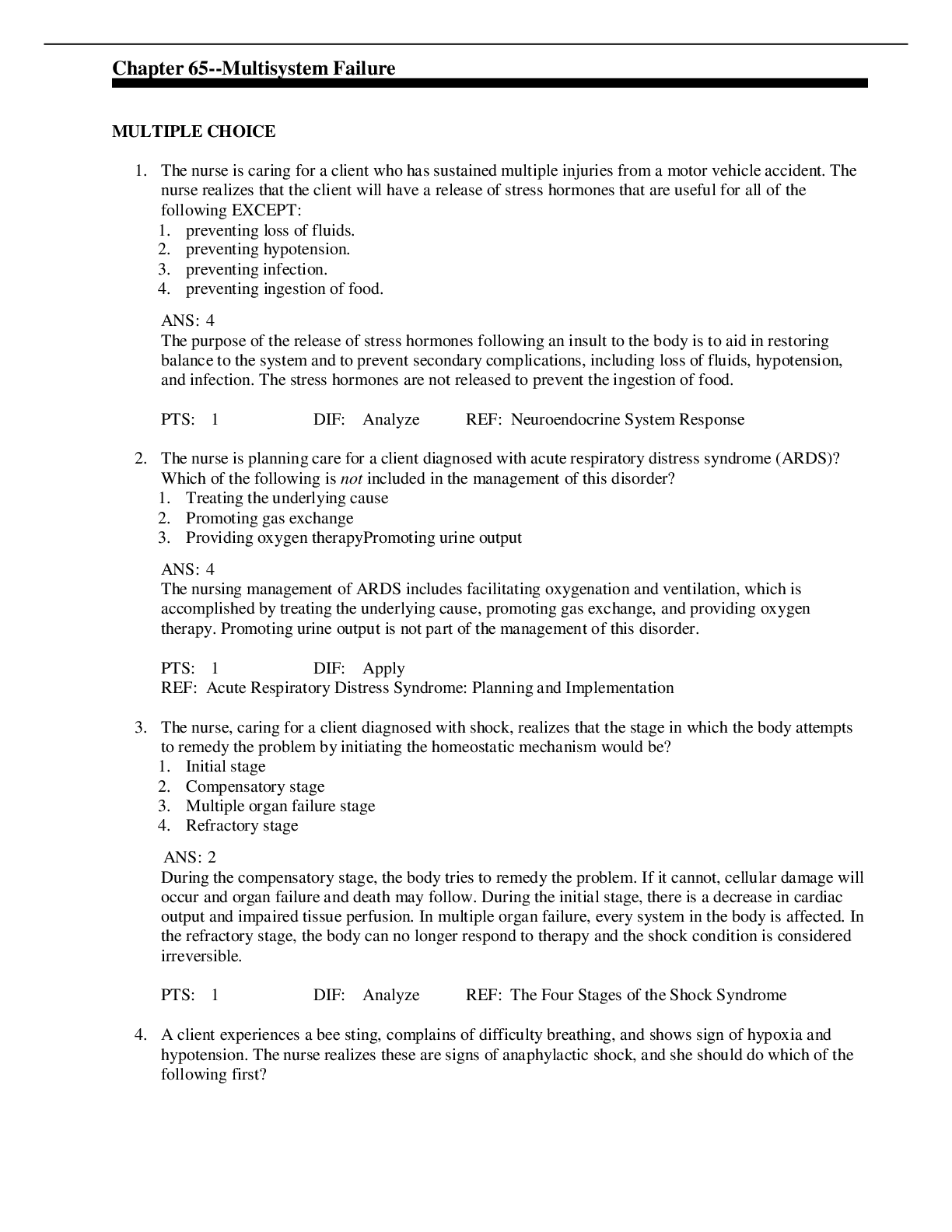
Reviews( 0 )
Document information
Connected school, study & course
About the document
Uploaded On
Sep 29, 2021
Number of pages
5
Written in
Additional information
This document has been written for:
Uploaded
Sep 29, 2021
Downloads
0
Views
44

.png)
.png)
.png)
.png)
.png)
.png)
.png)
.png)
.png)
.png)
.png)

.png)
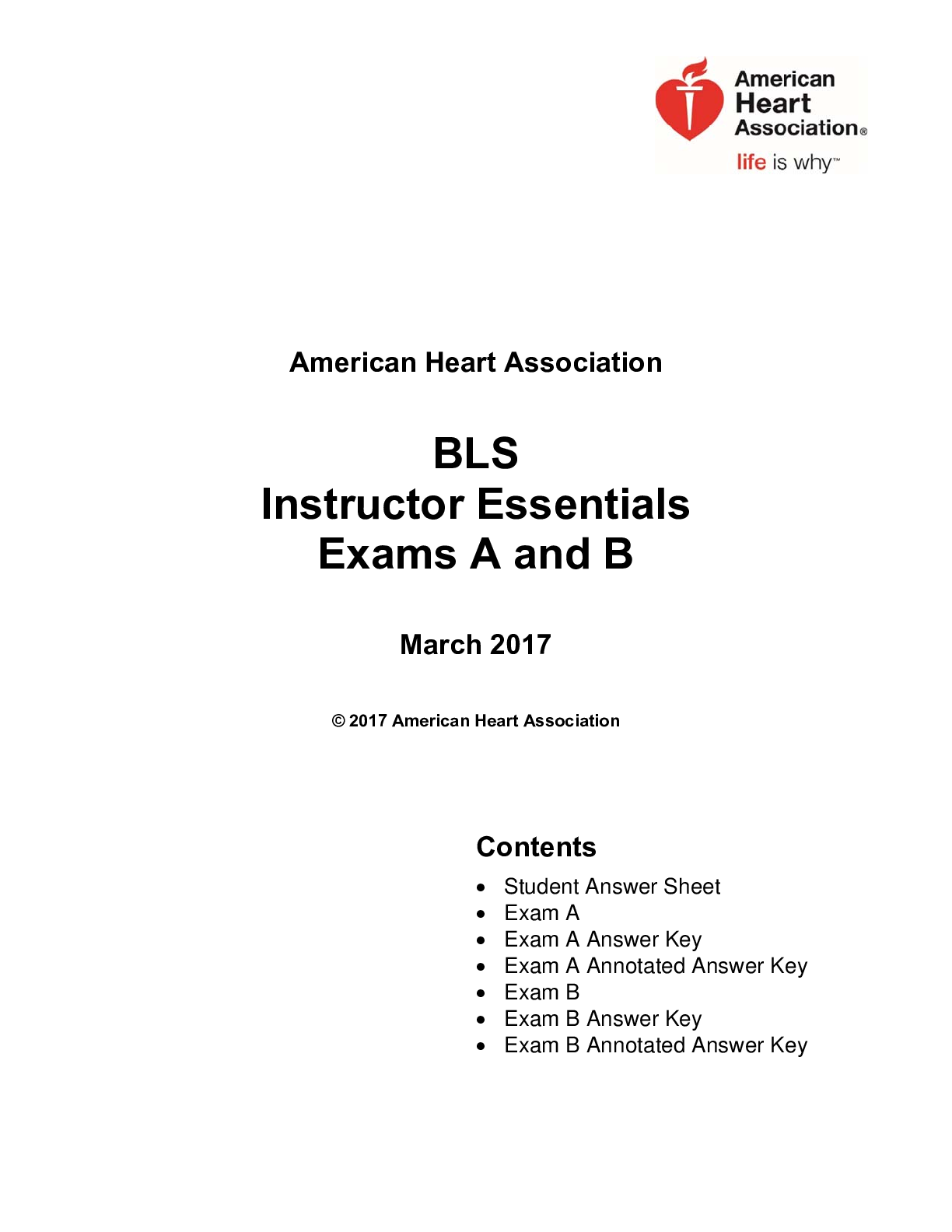
.png)
.png)
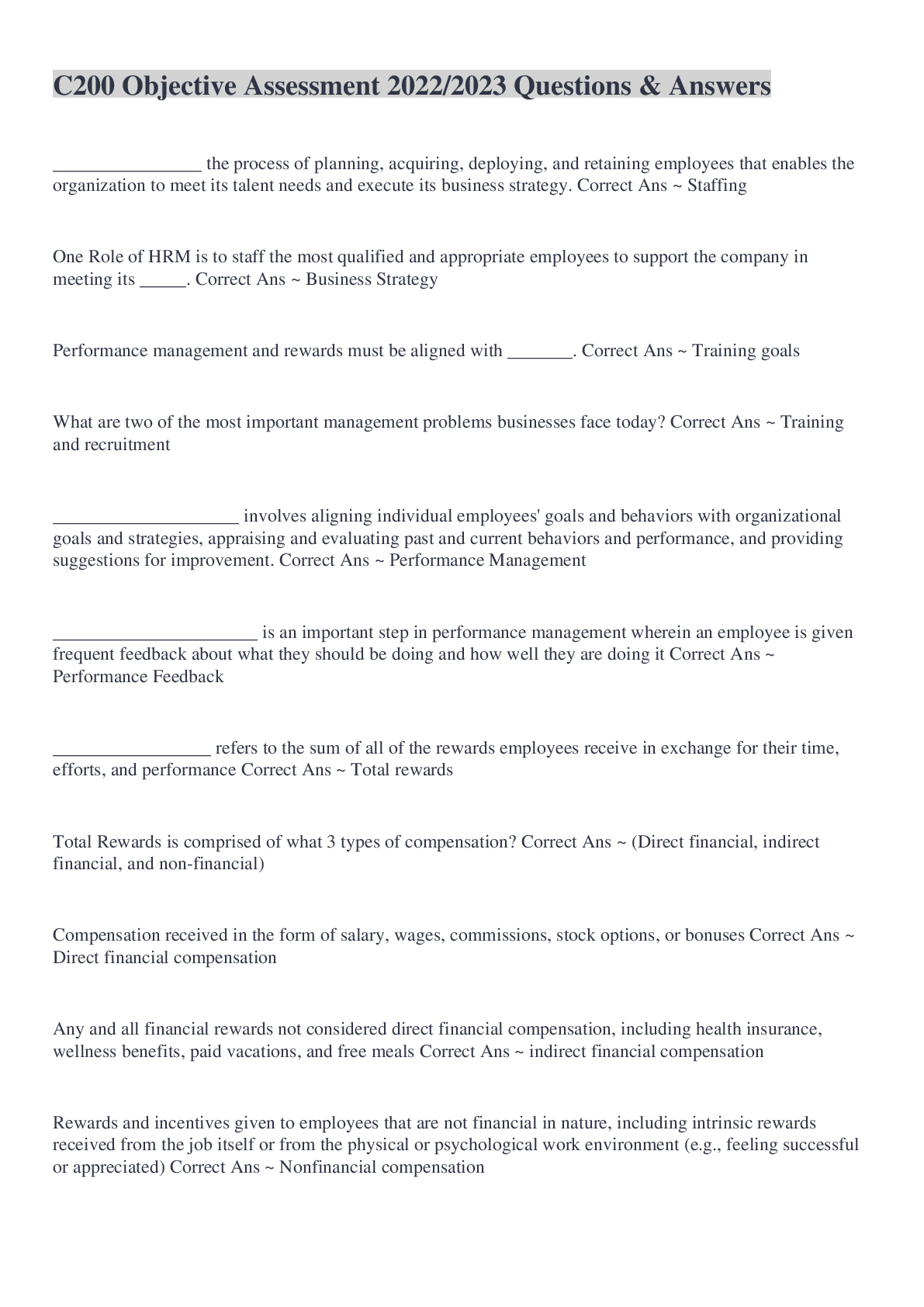
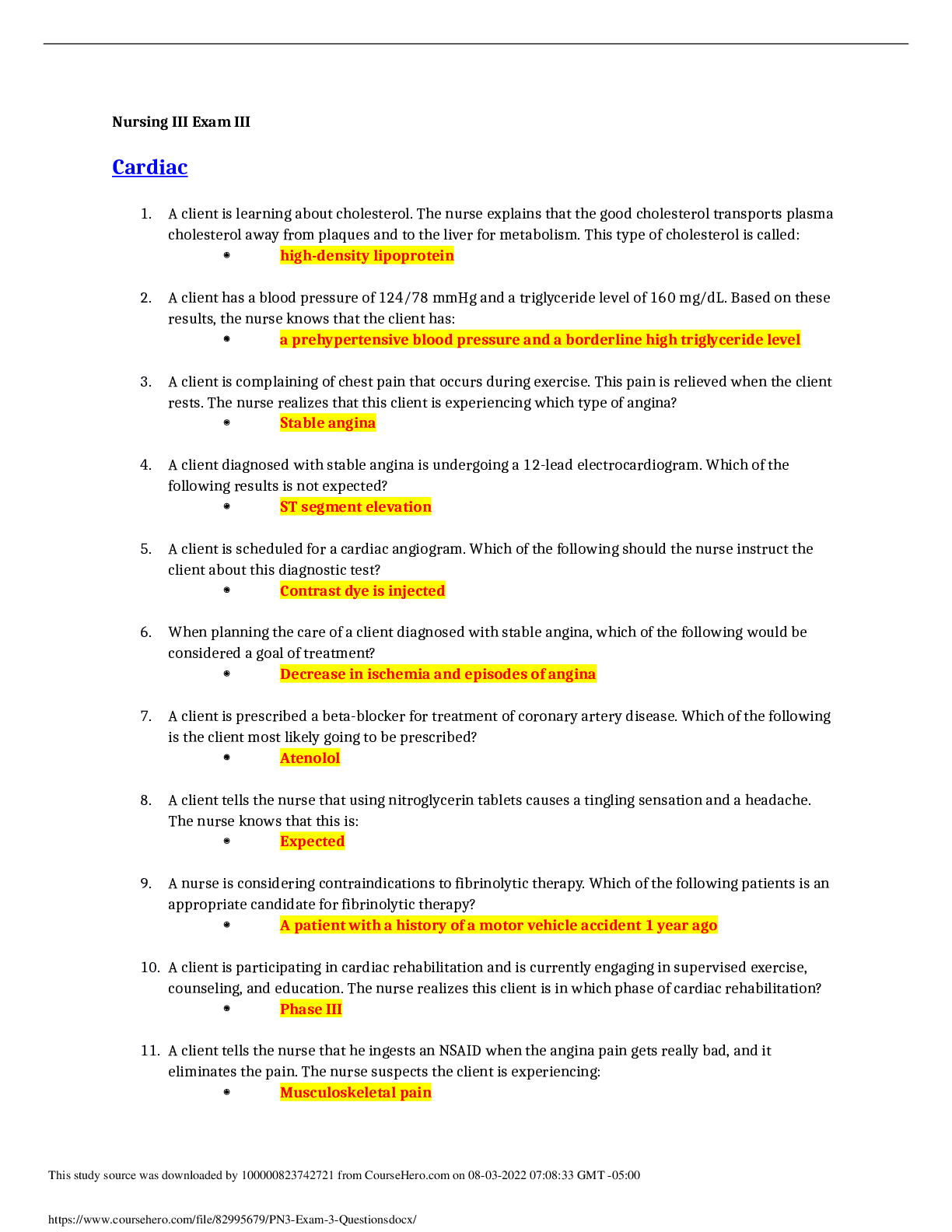

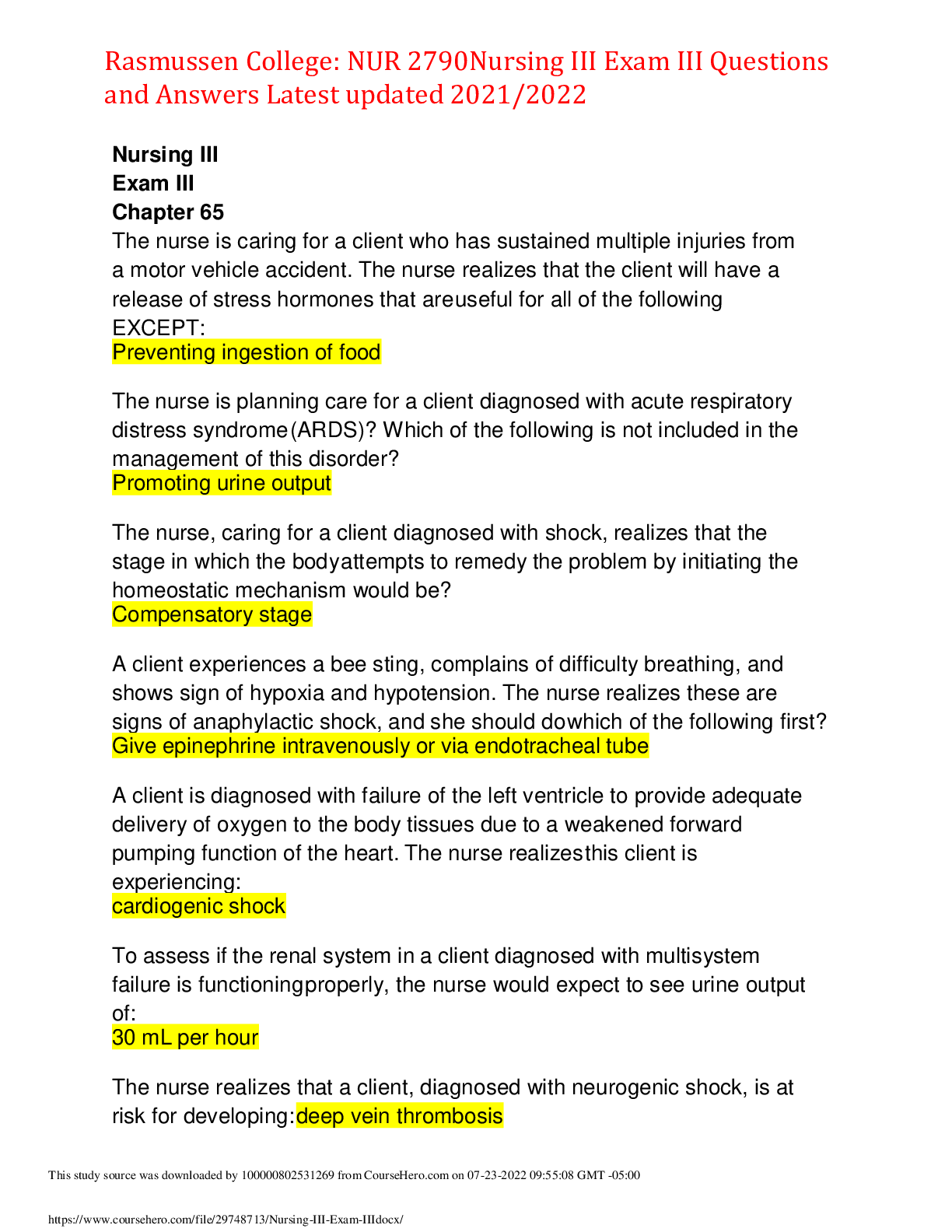
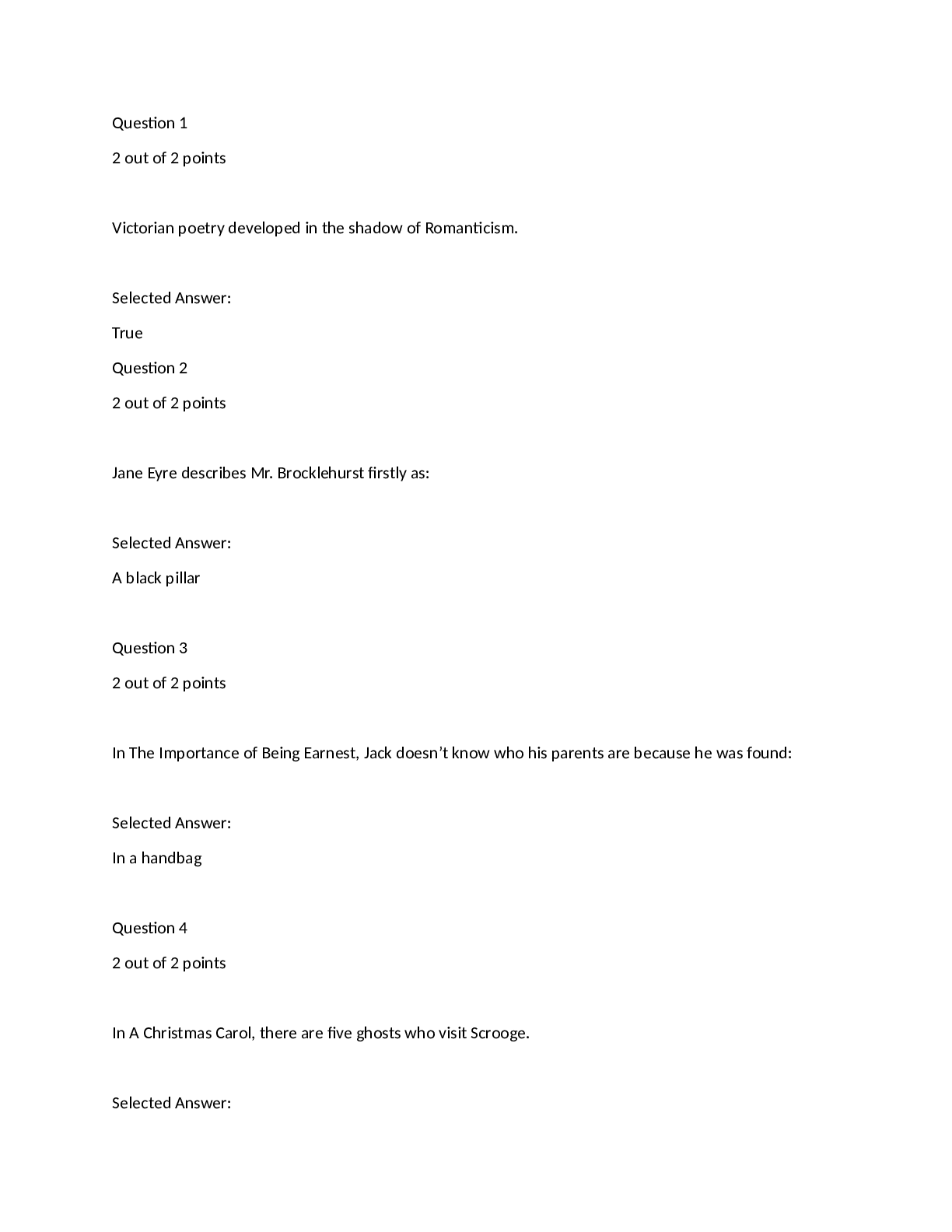
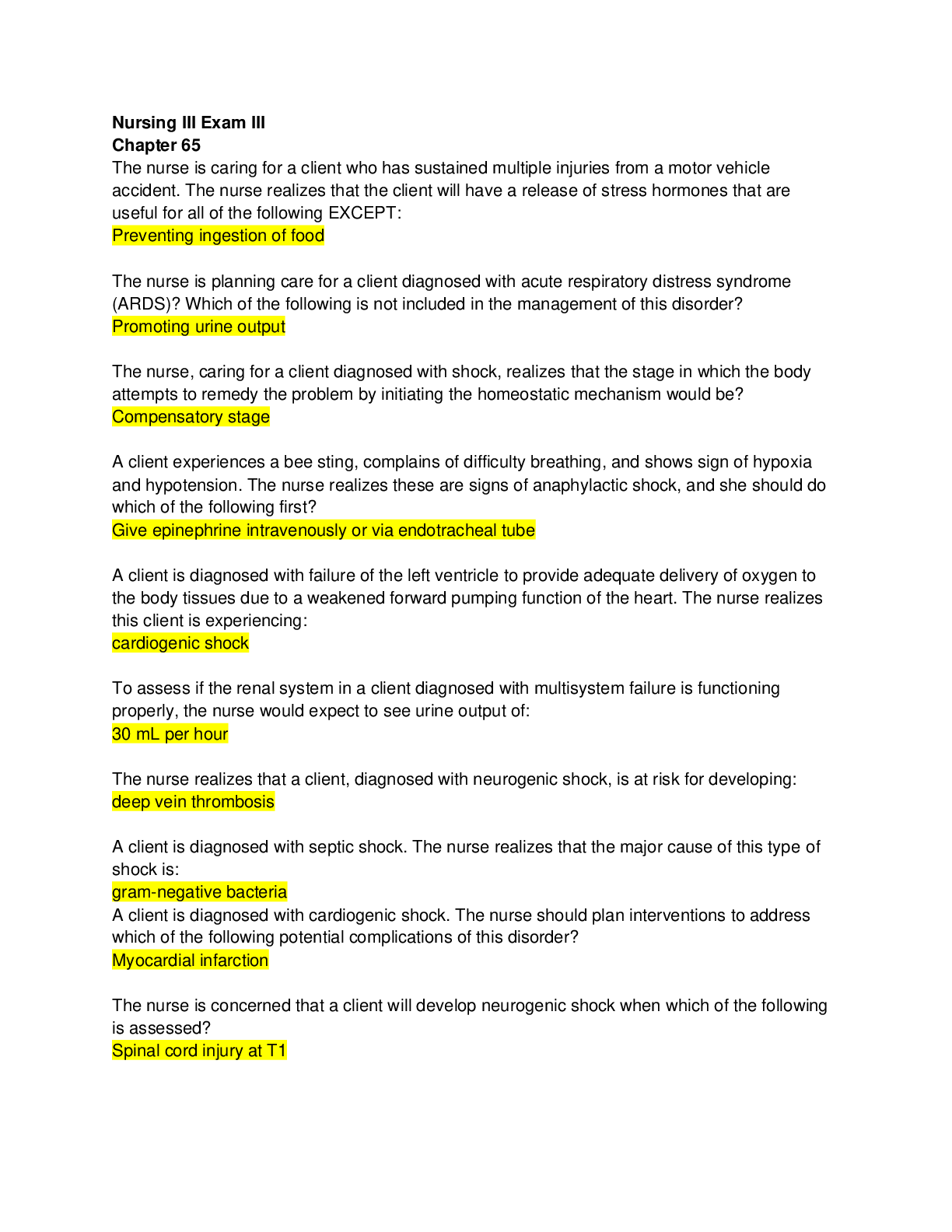
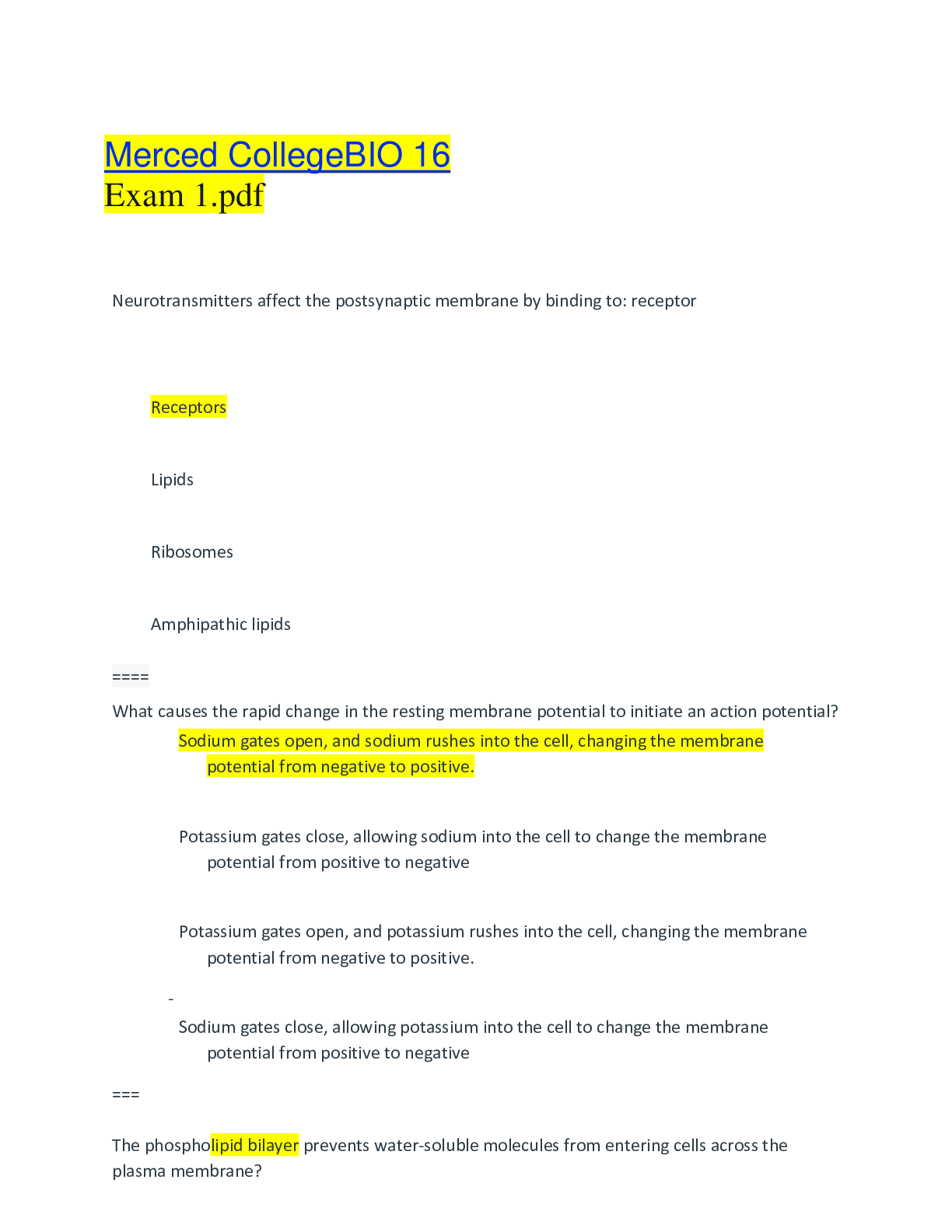
.png)
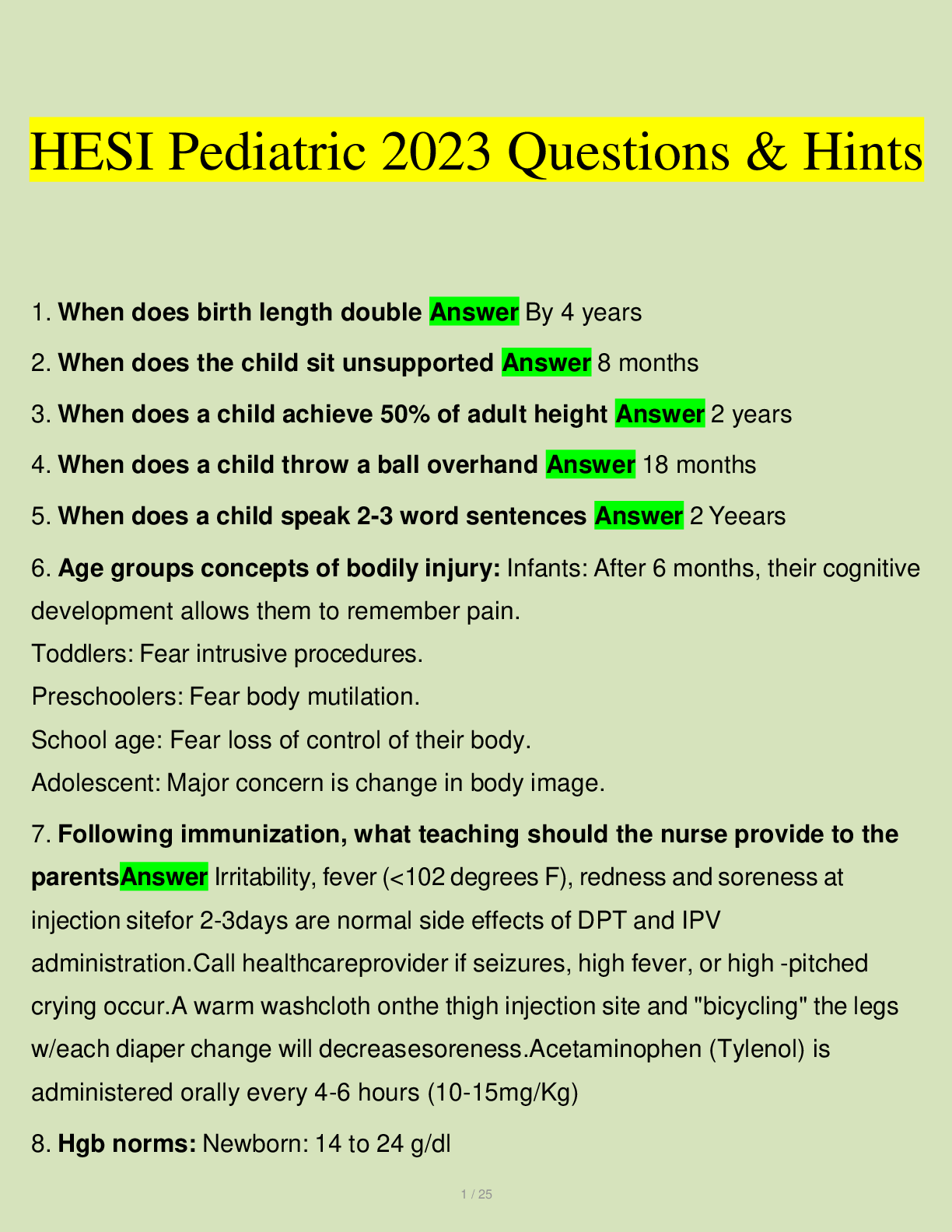



.png)

